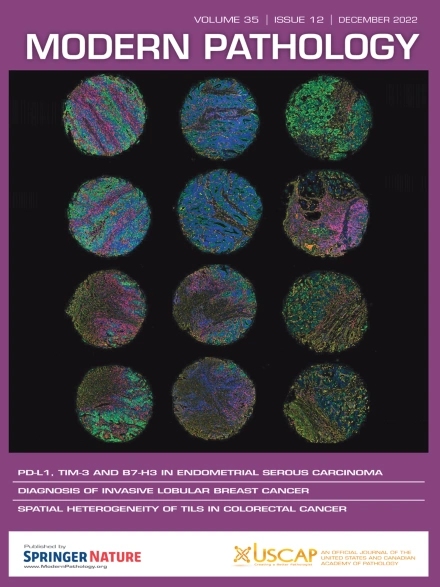利用人工智能对莫氏手术切片进行弱监督分类。
IF 7.1
1区 医学
Q1 PATHOLOGY
引用次数: 0
摘要
基底细胞癌(BCC)是最常见的皮肤癌,其发病率持续上升,尤其是在老年人中。这一趋势给医疗系统带来了巨大压力,尤其是在莫氏显微外科手术(MMS)所需的组织病理学诊断方面,该手术用于治疗敏感部位的 BCC,以尽量减少组织损失。本研究旨在开发和评估一种深度学习模型,通过注意力图将弱监督学习与可解释的基于分割的方法连接起来,从而解决在 MMS 整张幻灯片图像(WSI)中检测 BCC 所面临的挑战。利用来自两个医疗中心的数据集,该模型在内部测试中的平均 ROC 曲线下面积(AUC)为 0.958,在独立的第三个外部数据集上的 AUC 为 0.934,尽管后者没有进行微调或预处理。注意力图为模型的决策提供了洞察力,突出了滑动水平分类的关键区域。在未应用过滤的情况下,注意图定位肿瘤区域的灵敏度为0.853,平均每张幻灯片有8个修正误报,而当从注意图中剔除小于200微米的检测时,误报减少到平均每张幻灯片2个,灵敏度为0.873。这些研究结果表明,深度学习模型在检测 MMS WSI 中的 BCC 方面非常有效,在不同的数据集和条件下都有很好的表现。注意力图的使用增强了模型的可解释性,使其成为辅助皮肤病理学家和MMS外科医生的一种有前途的工具。本文章由计算机程序翻译,如有差异,请以英文原文为准。
Weakly Supervised Classification of Mohs Surgical Sections Using Artificial Intelligence
Basal cell carcinoma (BCC) is the most frequently diagnosed form of skin cancer, and its incidence continues to rise, particularly among older individuals. This trend puts a significant strain on health care systems, especially in terms of histopathologic diagnostics required for Mohs micrographic surgery (MMS), which is used to treat BCC in sensitive locations to minimize tissue loss. This study aims to address the challenges in BCC detection within MMS whole-slide images by developing and evaluating a deep learning model that bridges weakly supervised learning with interpretable segmentation-based methods through attention maps. Utilizing data sets from 2 medical centers, the model demonstrated an average area under the receiver operating characteristic curve (AUC) of 0.958 on internal testing and an AUC of 0.934 on an independent third external data set despite no fine-tuning or preprocessing for the latter. Attention maps provided insights into the model’s decision making, highlighting critical regions for slide-level classification. The sensitivity of the attention maps in localizing tumor regions was 0.853 when no filtering was applied and gave 8 revision false positives per slide on average and was reduced to an average of 2 false positives per slide with a sensitivity of 0.873 when detections smaller than 200 μm were removed from the attention maps. These findings indicate that the deep learning model is highly effective in detecting BCC in MMS whole-slide images, with robust performance across different data sets and conditions. The use of attention maps enhances the model’s interpretability, making it a promising tool for aiding dermatopathologists and MMS surgeons.
求助全文
通过发布文献求助,成功后即可免费获取论文全文。
去求助
来源期刊

Modern Pathology
医学-病理学
CiteScore
14.30
自引率
2.70%
发文量
174
审稿时长
18 days
期刊介绍:
Modern Pathology, an international journal under the ownership of The United States & Canadian Academy of Pathology (USCAP), serves as an authoritative platform for publishing top-tier clinical and translational research studies in pathology.
Original manuscripts are the primary focus of Modern Pathology, complemented by impactful editorials, reviews, and practice guidelines covering all facets of precision diagnostics in human pathology. The journal's scope includes advancements in molecular diagnostics and genomic classifications of diseases, breakthroughs in immune-oncology, computational science, applied bioinformatics, and digital pathology.
 求助内容:
求助内容: 应助结果提醒方式:
应助结果提醒方式:


